
We’re delighted to interview the creators behind Mamie Tape Fights To Go To School, based on the true story of an eight-year-old Chinese American changemaker who fought for the right to go to school in San Francisco in the 1880s.
Title: MAMIE TAPE FIGHTS TO GO TO SCHOOL
Author: Traci Huahn ~ Illustrator: Michelle Jing Chan
Publisher: Crown Books for Young Readers/Penguin Random House
Publication date: May 7, 2024

Traci Huahn (she/her) writes books for kids and especially loves stories rooted in Asian American culture, history, and identity. MAMIE TAPE FIGHTS TO GO TO SCHOOL is her debut picture book. As a former attorney and the daughter of Chinese immigrants, she feels a deep connection to Mamie’s story and hopes it will inspire young readers to become changemakers, even if they start by taking just one small step. Visit Traci at her website and on Instagram, Twitter, and Bluesky.

Michelle Jing Chan is a queer Chinese American author-illustrator who works on picture books and comics for kids and teens. Ever since she could hold a pencil, Michelle has loved using art to bring the daydreams in her head to life. Her work has been featured in the WING LUKE MUSEUM, BUZZFEED, and UPWORTHY. She aspires to illustrate diverse, empowering stories her younger self would have loved.
When she’s not drawing, Michelle is petting the neighborhood cats, obsessing over a book, or binge-watching spooky TV shows. Visit Michelle at her website, TikTok, Bluesky, Threads, orTwitter.

Synopsis: Meet 8-year-old Chinese American changemaker Mamie Tape. Mamie’s mom always reminded her that ”a journey of a thousand miles begins with a single step.’‘ So when Chinese children weren’t allowed at school, Mamie took her first step and showed up anyway. When she was turned away, Mamie and her parents took another step: they sued the school board…and won! Their case Tape v. Hurley made its way up to the California Supreme Court, which held that children of Chinese heritage had the right to a free public school education. But even then, Mamie’s fight wasn’t over.
QUESTIONS .
Q. How was MAMIE TAPE FIGHTS TO GO TO SCHOOL created?
Traci: I’m a former lawyer and was inspired to tell Mamie’s story after learning about her case. I’m a bit compulsive when it comes to research, so I spent months digging up everything I could (and maybe going down a rabbit hole or two!) A really fun thing I did was visit the California State Archives to page through the actual legal documents filed by the lawyers in 1885. I also interviewed some of Mamie’s relatives, which was very special. And I was amazed by all the old newspaper articles related to Mamie’s case.
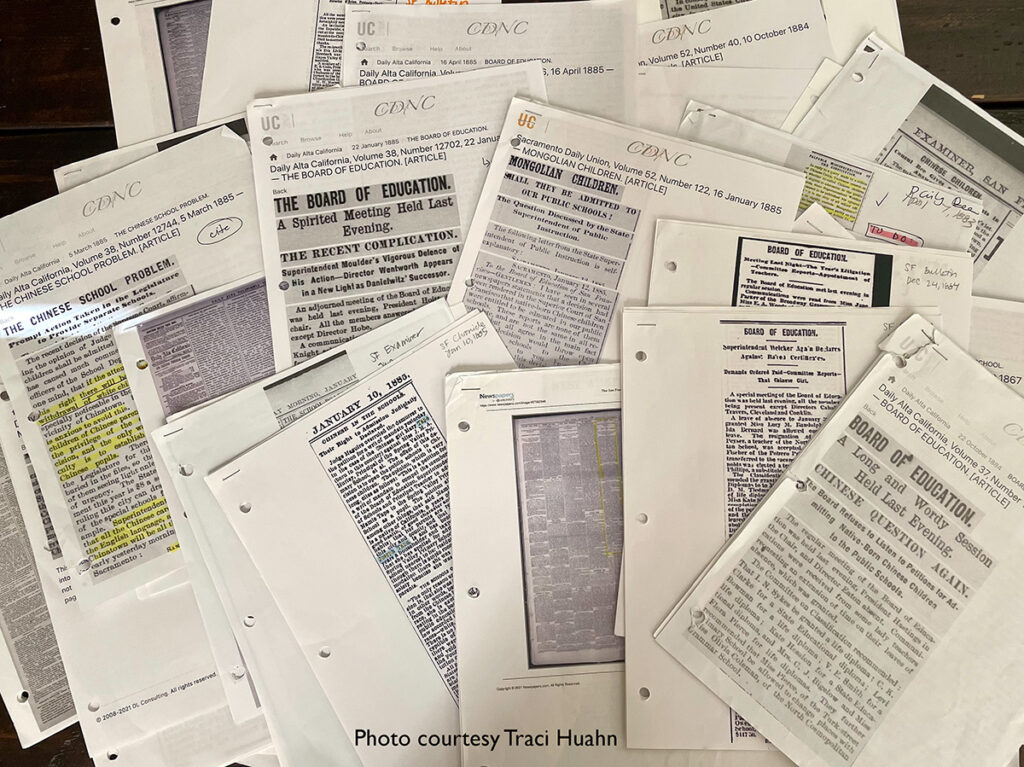
The book is heavily fact-based, but I chose to write it as historical fiction so I could tell it from Mamie’s point of view and allow young readers to step inside her shoes. I used Chinese philosopher Laozi’s proverb–a journey of a thousand miles begins with a single step–as a refrain because it so poignantly sums up not only Mamie’s long journey fighting to go to school, but that of so many others who have fought for equality. For years I’ve had a bookmark inscribed with that quote and as I started realizing all the steps Mamie had to take, it quickly came to me as a beautiful way to frame her story.
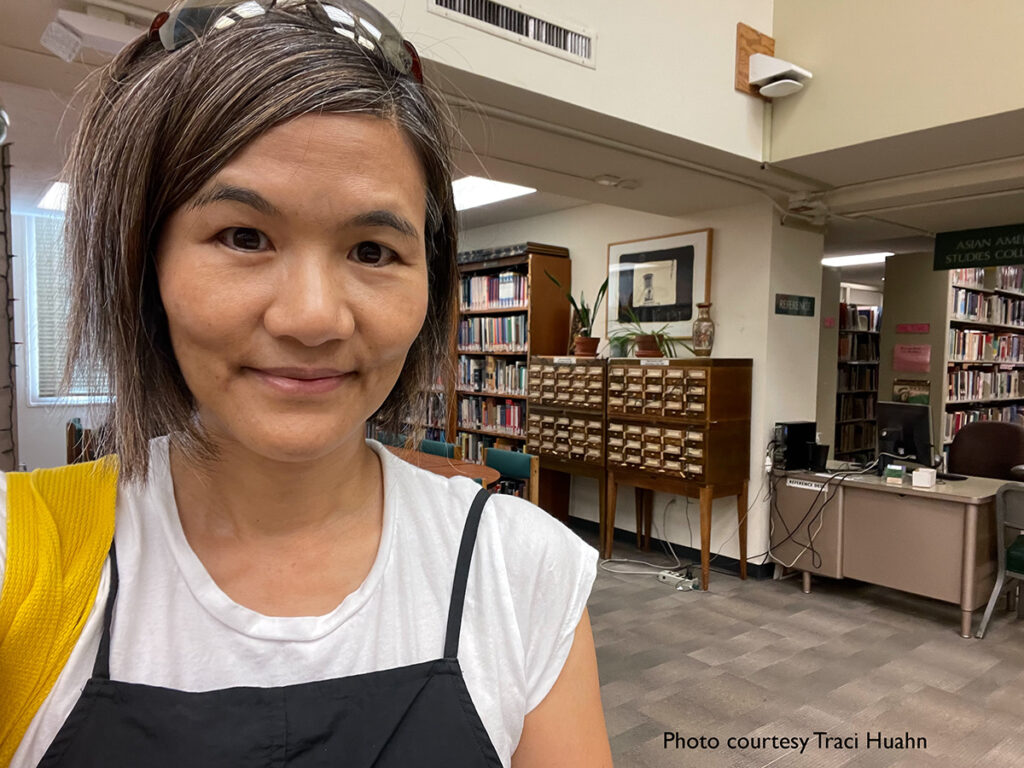
As far as the path to publication, a bit of serendipity was definitely involved. During the Kweli Color of Children’s Literature Conference in 2021, I signed up for an editor critique, but the original editor couldn’t do it. Instead,I was assigned to my now editor Phoebe Yeh. But rather than give me feedback, she asked to share my story with her team, and everything took off from there! Of course, Phoebe later did have some comments and there was some back and forth to get the book to where it is now. As Michelle also mentions, the entire process was very collaborative between me, Phoebe, Michelle and art director Jan Gerardi. (Though everything went through Phoebe and Jan, and Michelle and I didn’t have direct contact until after the book was finalized.)
Michelle: This book was a little different from other picture books I’ve illustrated in that this is based on a historical true story. Unlike previous books where I collect references myself, Traci graciously provided a document with historical references that she compiled, including photos of San Francisco in the 1800s, newspaper clippings, and accounts from Mamie’s surviving relatives. This document was invaluable when I was illustrating the book. From sketches to final art, my art director (Jan Gerardi) and I constantly referred to it to be sure that the historical details were being captured accurately. Everything from the outfits, the geography, the wallpaper patterns, the food, and the architecture was vetted against Traci’s reference document for historical accuracy.
One unique challenge with this book was that a lot of the photos were black and white or low quality due to the limitations of the technology at that time. Sometimes it was tricky to see the exact details in the photo, so it was a collaborative process between me, Traci, Jan, and Phoebe (our editor) to interpret the photos as best as we could.
Here’s an example of one of the spreads from the book: I started with a very messy sketch (I like to sketch super loosely!) based on the description from this newspaper article Traci provided of the interior of the Tape family home.
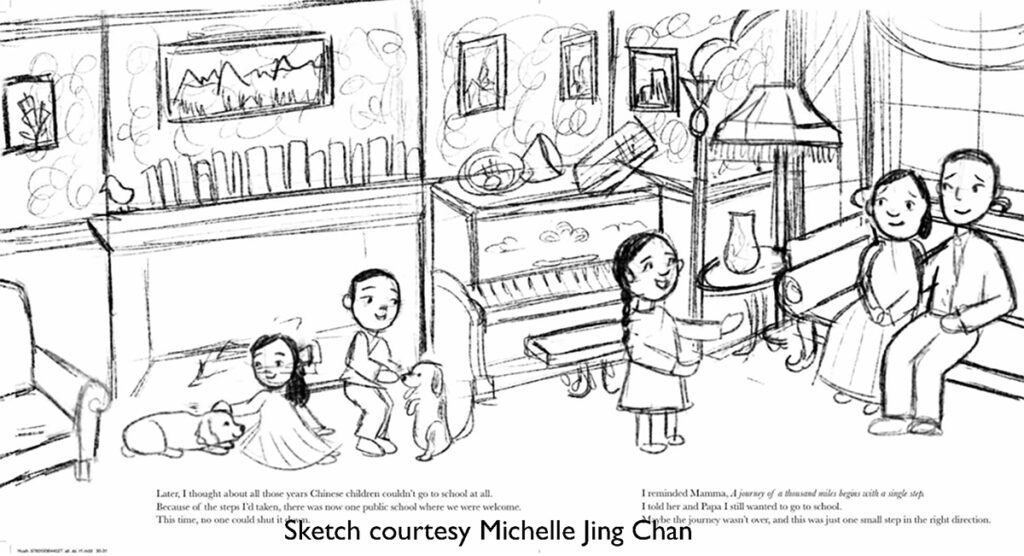
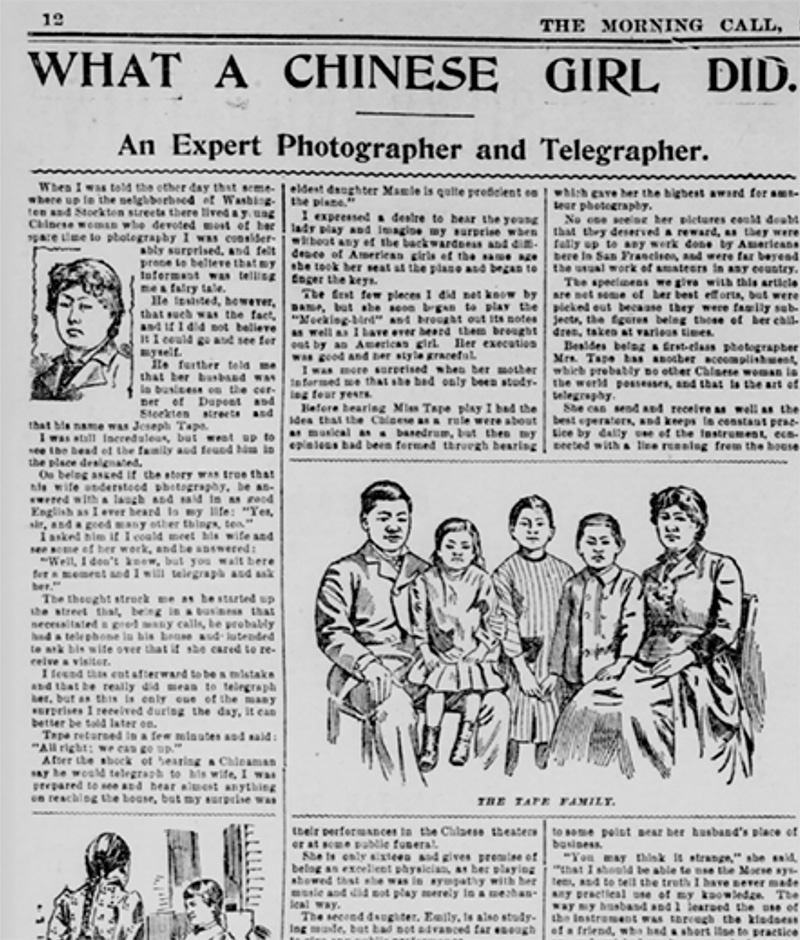
After my sketches were approved, I went straight to final color. As I was coloring, I referred to the same newspaper clipping, now giving attention to details like the decor. Items like the stuffed bird, books, piano, and instruments were actual items mentioned in the newspaper article. The paintings on the wall were based on paintings by Mary Tape, Mamie Tape’s mother. The dogs were based on a photo of the Tape family’s dogs.
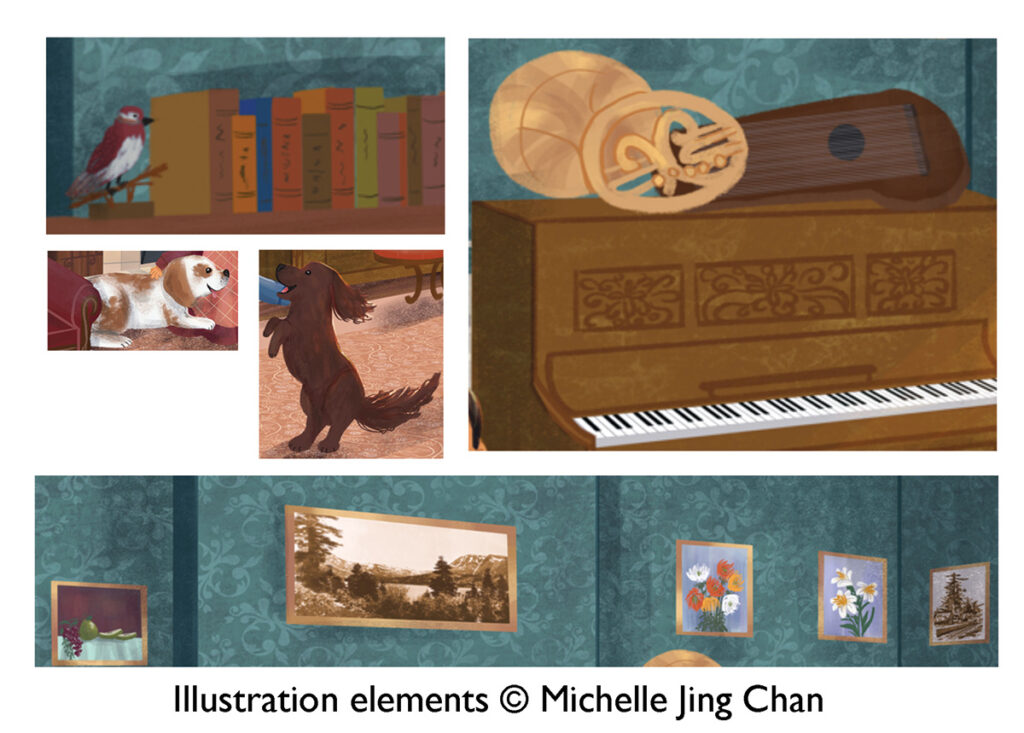
These details all came together in the final version of the spread, which hopefully captures a sense of what the Tape home would have looked like!

Q. What do you hope young readers will take away from your book?
Traci: I hope young readers will recognize that whenever they see or experience unfairness, they have the power to make a difference, just like Mamie did, and to have persistence. Even though change often takes a very long time, it is always worth fighting for and begins by taking that first step.
Michelle: I hope that this book brings Mamie’s story to a wider audience. Growing up, I didn’t learn about Mamie Tape in history class; it wasn’t until I was an adult that I learned about her and the broader Asian American involvement in the fight against racial injustice.
On a personal note, like Mamie, I am also the daughter of Chinese immigrants. Her story reminded me of my parents’ and grandparents’ own struggles. Like her parents, mine fought to provide their children with the educational opportunities they didn’t have. I hope that readers–especially immigrants or children of immigrants–will see themselves in Mamie’s persistence and be inspired by how even the smallest actions can bring impactful change.
Q. What advice do you have for young writers?
Traci: Don’t be afraid of the terrible first draft! So much of writing is really rewriting. Again. And again. Remember, no one has to see your first draft, but the only way to make progress is to get your words out. I can’t even begin to tell you how many versions I wrote of this manuscript before it ever went to Phoebe!
Michelle: While I believe it’s important to practice and improve your craft, I also believe that it’s equally important to venture out into the world and experience life! Inspiration for new stories and illustrations has hit me at the most unexpected of times, even when I’m learning or doing something that is completely unrelated to art or books. For example, I learned to rollerblade during the pandemic and was able to use some videos of myself skating as references for a spot in the book where Mamie skates with her friends. Your experiences broaden your worldview and inform the stories you can tell through your work.
Q. What are you excited about now?
Traci: I’m excited to launch this book and start connecting with young readers at school visits and other events. I’m also continuing to write stories that are in some way tied to my Asian American identity. I’m very grateful that I got to work with such a wonderful team at Crown BFYR and partner with Michelle as illustrator for my debut book – it’s been such a positive experience and I look forward to bringing more books into the world, though nothing to announce…yet!
Michelle: In addition to this book, I’m stoked about two other picture books I illustrated releasing in 2024: STAY ANGRY LITTLE GIRL, inspired by the words of Madeleine L’Engle’s A WRINKLE IN TIME (Macmillan), and GOODNIGHT SOUNDS (Bloomsbury).
And even though they’re not releasing for a while, I’m also excited about my author-illustrator debut picture book, CELEBRATING DONG ZHI (Bloomsbury) and my debut graphic novel, SOMEWHERE IN THE GRAY (Macmillan). I feel so grateful every day that I get to make art and books and work with talented, kind collaborators like Traci!
Cover reveal and related interview here.
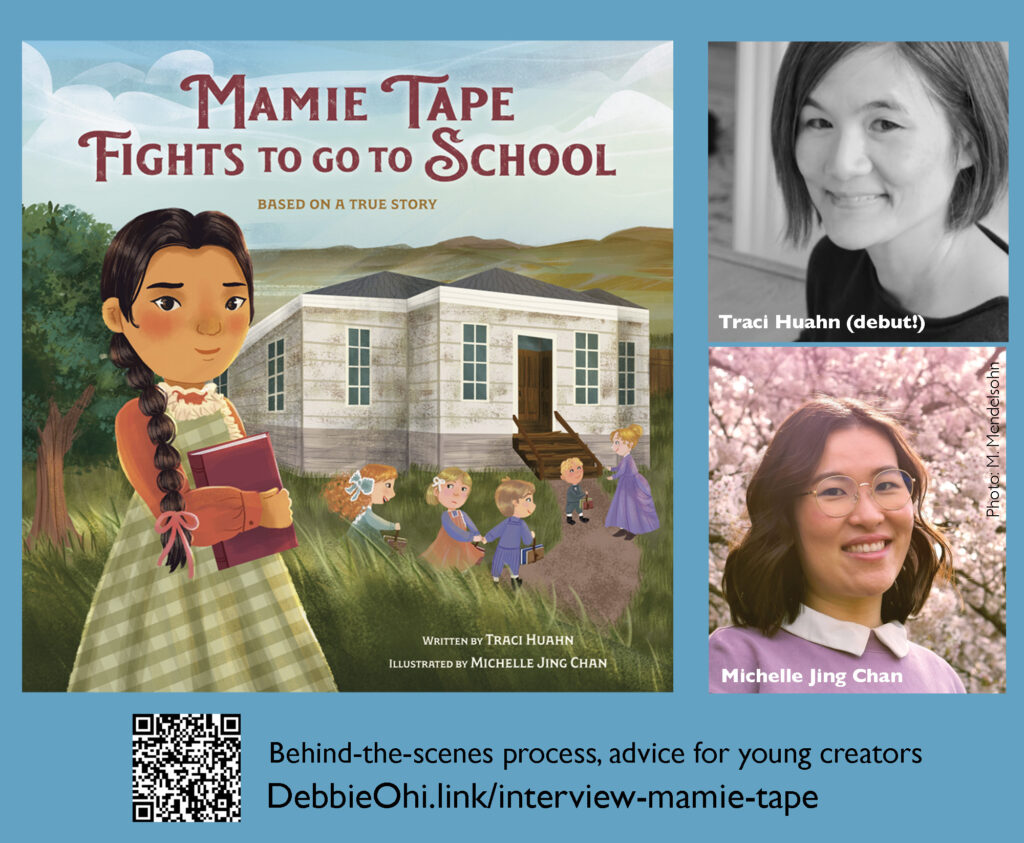
_________________________________________________________________________________
Also see other Interviews with Book Creators and Advice For Young Writers And Illustrators.

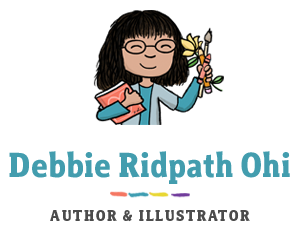
Great interview, all! I’m looking forward to reading your book.